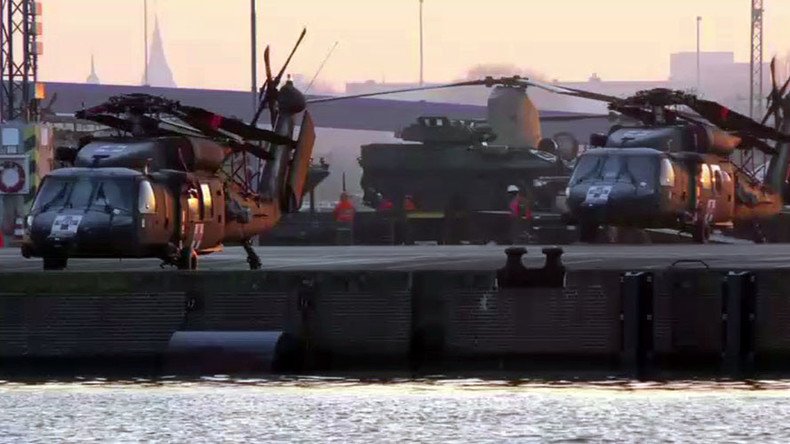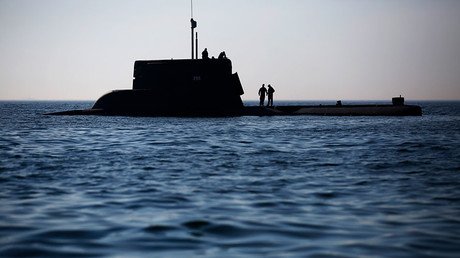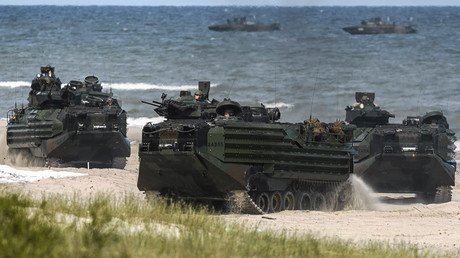US military helicopters arrive in Germany amid NATO buildup in E. Europe (VIDEOS)

Dozens of US Chinook, Apache, and Black Hawk helicopters have been unloaded in the German port city of Bremerhaven, as NATO continues boosting its combat presence in Eastern Europe to counter the perceived ‘Russian threat.’
The shipload of American military hardware included 49 helicopters and several trucks from the US 10th Combat Aviation Brigade stationed at the base in Fort Drum, New York, according to DPA news agency. Most equipment will then be transported to the NATO base in the German town of Illesheim, while other pieces of military hardware will be sent to other countries like Lithuania and Romania.
“Today, we are downloading a portion of the combat aviation brigade and it will be moved to Germany and Eastern Europe and will be scattered between Latvia and Romania, while a big chunk of it will be stationed in Germany,” Major General Duane Gamble, the Commander of the 21st Theater Sustainment Command, which is lead organization for the US Army Europe’s logistic support and other sustainment activities, told journalists.
The general added that the mission of the air grouping “is to train with our NATO allies… and to strengthen our alliance together.” He also said that “one of the key training objectives here is to continue to refine our agility in different [ways].”
“For 70 years, the US has been one of the cornerstones of NATO and there is no better way to train with our NATO partners than on the continent of Europe,” he stressed, adding that the US troops will be deployed to four NATO countries: Belgium, Germany, Latvia, and Romania.
The deployment marks another phase of Operation Atlantic Resolve, which began in April 2014, following the Crimean referendum to split from coup-stricken Ukraine and join Russia. Atlantic Resolve is perceived by Washington as a demonstration of continued US commitment to the collective security of Europe in the view of an alleged Russian “assertiveness.”
US troops will be constantly stationed in the Eastern European countries on a rotational basis in this operation. It particularly involves deployment of 94 US helicopters and 2,200 US soldiers to various military facilities in Eastern Europe between February and November 2017, German media report.
In January, 2,800 pieces of US military hardware, including US Abrams tanks, Paladin artillery, and Bradley fighting vehicles, and 4,000 troops arrived in Europe as part of the operation. These forces then moved on to Poland to participate in military drills in late January, and then were deployed across seven countries, including the Baltic States, Bulgaria, Romania, and Germany. A headquarters unit is stationed in Germany.
More than 50 units of US military equipment, including four battle tanks and 15 infantry fighting vehicles, were then delivered to Estonia in early February. The personnel of the Charlie Company of the 68th Armored Regiment’s 1st Battalion from the US Army 4th Infantry Division arrived in the town in late January.
In July 2016, NATO members agreed to the “biggest reinforcement since the Cold War,” posting four multinational battalions to Estonia, Latvia, Lithuania, and Poland.
Germany, Canada, and Britain are also contributing to the significant NATO buildup in Eastern Europe, and are sending battalions of up to 1,000 troops each to Estonia, Latvia, and Lithuania.
In late January, Germany began deploying troops to Lithuania. The German command said it was sending about 200 military vehicles and 30 tanks, including Marder armored infantry fighting vehicles and Leopard 2 battle tanks, along with 450 troops. The movement of forces will continue until late February, it added.
The move came amid joint US-Polish military drills, involving the 3,500-strong 3rd Armored Brigade Combat Team, 4th Infantry Division, from Fort Carson, Colorado near the Polish town of Zagan. The troops demonstrated resolve to deter any “unlikely” potential aggression from Russia.
While NATO members continue to point to the perceived “Russian aggression,” calling it “a source of instability,” Russia consistently denies the allegations. Moscow also criticizes the NATO buildup on its borders, as well as in Poland and Germany, by saying that it increases the risk of incidents and poses a threat to Russian national security.
“This deployment is of course a threat for us,” Russian Deputy Foreign Minister Aleksey Meshkov said on February 9, adding that “it is obvious that the steps by NATO gravely increase the risk of incidents [between NATO and Russian forces].”
NATO’s increased activities in the Black Sea also provoked angry reactions from Russia. “Regarding NATO’s activities… here our Western colleagues prefer to deal with virtual and generally non-existent threats,” Russian Foreign Ministry spokeswoman Maria Zakharova said, referring particularly to the recent Sea Shield 2017 held by Romania.
According to the Romanian Navy, about 2,800 troops from Romania, Bulgaria, Greece, Turkey, Canada, the US, and Ukraine took part in the maneuvers. The naval drills involved 16 warships and 10 warplanes. The exercises were held in the eastern part of the Black Sea, not far from Russia's borders.
Since the spring of 2014, NATO warships, including missile cruisers from the US and other allied nations, have been patrolling the Black Sea on a rotational basis, never leaving the area unattended.














